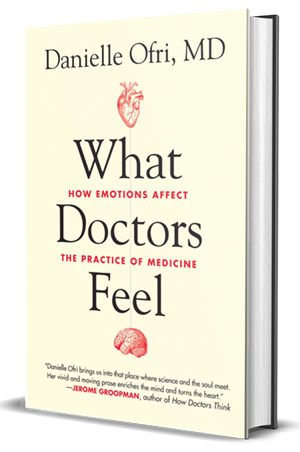Clinical Correlations review of “What Doctors Feel”
by Michael Tanner
Clinical Correlations
What Doctors Feel, Danielle Ofri’s answer to Jerome Groopman’s How Doctors Think, explores how doctors’ emotions affect the practice of medicine in good and bad ways. As the saxophone virtuoso Charlie Parker said, “If you don’t live it, it won’t come out of your horn.†Dr. Ofri has lived it, in a career more varied than most—as a rape crisis counselor, a neuroanatomy teaching assistant, a cellist, a PhD in neuroscience, and a professor and practitioner of internal medicine—not to mention a mother of three. She knows her subject deeply and from complementary angles.
“The amygdala is ground zero for the processing of fear in human beings. I remember the first time I laid eyes on an actual amygdala, after slicing through a brain with a repurposed kitchen knife in neuroanatomy class. That’s it? I thought. That nickel-size splotch tucked below the temporal lobe was the seat of my fears?â€
Her Bellevue, the venerable New York safety-net hospital where most of the stories take place, is startlingly accurate. I know, since I have been her colleague there for many years. This is the tempo:
“Chemotherapy infusion protocols conflict with CT scanner availability, but bronchoscopy can only be done after the CT scan, however the pulmonologist was called away to an emergency so the bronchoscopy needs to be rescheduled. Mrs. Baradi spiked a fever so chemo needs to be canceled and the patient in the next bed over just developed an unusual rash so he needs to be moved to an isolation room, but the ER is backed up with admissions so five new patients are coming to the ward at the same time and no isolation beds are available…â€
They are all here: disgusting patients, entitled patients, lovable patients, somatizing patients, litigious patients, patients with a terrible diagnosis that you know about but they don’t. Burnt-out doctors, bullying doctors, alcoholic doctors, frightened doctors, embarrassed doctors (that would be Danielle herself, in the great chapter “Burning With Shameâ€). Exhaustion, grief and mourning, fear of looking stupid, fear of harming one’s patient and getting sued. What Doctors Feel is filled with heartfelt examples of all of these. By the end of the book, it is a wonder that there is anything left of the author’s central nervous system, or ours. What a gut-wrenching line of work we have chosen! She has proven that the “equanimity†recommended by the great Dr. William Osler to medical school graduates in 1889 is impossible. After reading Dr. Ofri’s book I have a better understanding why at the end of a busy clinic session I have trouble naming the seven patients I have just seen. We must jettison a great deal of emotional bilge in order to do it all over again the next day.
The years-long story of her patient Julia, a young woman with end-stage congestive heart failure who is up for a heart transplant, weaves through the book’s seven chapters, providing structure and a fleeting glimpse of that rarest of doctorly emotions, pure joy.
She is at her telling-the-truth best here at the end of chapter 4, titled “A Daily Dose of Deathâ€:
“Integrating sadness while still being able to function and give of yourself is necessarily a work in progress. It is something akin to two coils spinning. The coil of sadness never stops—there is always an awareness that your patients are suffering and the suffering of the patients you’ve lost. The other coil is the engine of what you are giving to your new patients, the investment in their lives and health. Though nobody desires grief in one’s life, wise and experienced clinicians will tell you that they’d never want that coil to disappear.â€
Dr. Michael Tanner is the Associate Editor, Clinical Correlations











